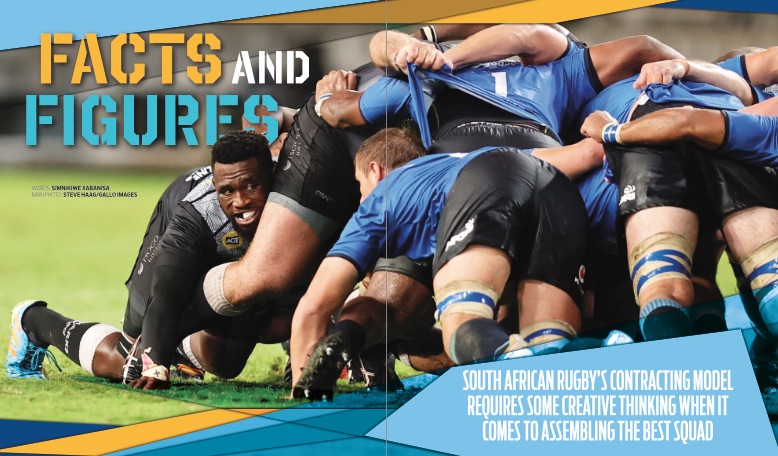South African rugby’s contracting model has required some creative thinking when it comes to assembling the best squad, writes SIMNIKIWE XABANISA in the latest SA Rugby magazine.
Ever since the Bulls appointed former Springbok coach Jake White as their director of rugby last year, no week has felt complete without a major signing being announced.
Of course, that’s not entirely true, but their signings have been as frequent as they have been of the big-name variety, which has led the suspicious among us – no doubt with English club side Saracens’ fate still ringing in our ears – to wonder how they are beating the salary cap imposed in 2019.
And when you consider that the Sharks have joined the Bulls in the arms race to be the commercial superpower of South African rugby by giving US consortium MVM Holdings a majority stake in their company, and the Stormers have somehow retained many of their World Cup-winning Boks despite the shakiness of their finances, you have to wonder if everyone’s sticking to the letter of the salary cap law.
Before getting into whether everyone is colouring within the lines, maybe we should look at the reason of introducing the salary cap – the broad strokes of which are that franchises have a R60-million annual budget for no more than 45 contracted professional players.
Eugene Henning, the chief executive of the players’ organisation MyPlayers, said the thinking was simple: ‘We felt the industry was wasting money on salaries, and we could see it because we get the players’ pension fund contributions.
‘By paying so much and maybe overpaying players you lose the gems, so we felt maybe if we paid a little less and had a cap, then the industry would look after the current players better and wouldn’t be under so much financial pressure.
‘Having fewer players in the system meant the players had a good chance of making a career out of rugby; instead of being the fifth-best flyhalf at the Bulls, being paid R1.5m and not playing. Another reason we pushed hard for it was the franchises told us about four years ago that they were up against the ropes and couldn’t pay more, so we decided to help them cool down the market.’
MyPlayers researched what New Zealand and Ireland were paying their players, a fact-finding mission which revealed those countries – which were first and second-ranked in the world at the time – were paying the equivalent of R45-million per team while their South African counterparts were paying R57m.
‘We were paying R12m more per team than they were paying, so we needed to get into line.’
With the expectation that in all collective agreements someone is bound to step out of line, the Sharks and the Bulls’ riches on and off the field has led to suspicion that if anyone is applying a little Chinese accounting to the equation it would be them, considering their salary bills before the cap had been closer to R100m per annum.
It’s a perception that has made the free-recruiting Bulls prime suspects, but CEO Edgar Rathbone almost welcomed the opportunity to clarify that enduring narrative.
‘The salary cap is monitored from January to December, and for most of last season we had only 40 players instead of 45,’ he said. ‘We’ve walked away from a few transactions where we can see the numbers were being chased up.
‘We’ve got a fixed number that we can offer and as soon as the number goes over that, we walk away. The reality is, if a player really wants to come to the Bulls it’s not just going to be about money; and if it is we’ll walk away.’
Having worked as commercial manager at the Lions, Rathbone said there was a logical way to stay within the salary cap: ‘What is important is that you need to base your budget on real numbers. At the Lions we said our player budget was going to be based on numbers that we know.
‘Those are broadcasting and sponsorship rights because you know what that the are going to be. Any ticket or Test match revenue is flexible from year to year … that’s part of the thinking behind the salary cap, to help you plan your spending a lot better.’
Eduard Coetzee, Rathbone’s counterpart at the Sharks, said a similar approach meant they were ‘far under the salary cap at the start of 2020’.
‘We linked our player-spend to our revenue, and because our revenue went down, our player contracting went down. Obviously, now with the equity partners we’ve got a little more runway on our budget in terms of how much we can spend – but we’re not at the salary cap yet.’
As much as teams like the Bulls and the Sharks wouldn’t like to unnecessarily flex their newfound financial muscle, the system is flooded with World Cup winners, and clubs from France, England and Japan aren’t exactly on the same frugal plan as New Zealand and Ireland.
This means whether they like it or not, there comes a time when retaining high-profile players means going some way towards breaking the bank: For example, paying four World-Cup winners R5m a year could be 33% of your budget.
‘SA Rugby’s got the Players of National Interest (Poni) contribution, which falls outside of your salary cap,’ said Coetzee. ‘So you don’t have to pay the player’s whole salary; you only carry whatever you pay him above the Poni contribution.’
To that end, the Bulls have been at pains to make sure that most of the players they’ve attracted were also of interest to SA Rugby director of rugby Rassie Erasmus as well: ‘We’ve got a threshold where we won’t offer a player above X amount unless he gets Poni money; then as soon as he can get more Poni money, he can earn a higher amount.
‘We really chase players that are of national interest and will get Poni money.’
While local teams are counting their pennies, the overseas clubs – thanks largely to the exchange rate – have no such restrictions, which means the SA franchises or unions are vulnerable to whatever club may be interested in their players.
Coetzee admitted that this puts huge pressure on them, while Rathbone repeated his assertion that a desire to play for the Bulls was key for them: ‘It does put us under pressure, but it also forces you to develop young talent. That’s where you need to find that balance within your squad.
‘The perception is we just buy whoever we want and have this expensive squad but if you look at the team that played the Currie Cup final the back three [David Kriel, Kurt-Lee Arendse and Stravino Jacobs] were 21, 22, 23, and Elrigh Louw and Ruan Nortje are also youngsters.
‘Obviously, the higher profile your players are, the more interest there is from overseas, but for us it comes back to whether the player really wants to play for the Bulls.’
Third-party payments of player salaries have emerged as the contentious way around the salary cap, with the franchises seemingly believing it isn’t a problem. For example, the Stormers re-signing their high profile players is understood to be thanks to sponsor DHL committing to looking after those transactions. My Players say it is a problem.
The feeling from the franchises is, what constitutes a related third party; the thinking being that if a sponsor sponsors the team, how does it count as an arm’s length transaction? Put simply, they want it to not count towards the salary cap, like the Poni contributions.
Henning feels that money should be included in the capped salary budget: ‘That money should go in at the top, if you get a sponsor for R5m it should go in at the top then you as management decide how you spend it.
‘But your cap should still be your cap that you have per squad and you shouldn’t be paying more than that. The cap is R60m at the moment, if you want to pay R59m of that to one player and give the other million to the rest, you can do that.
‘What we don’t want is for you to pay R60m to all the players, and then get R10m from someone else and they pay that directly to that player for playing services. Then your cap goes from R60m to R70m.’





